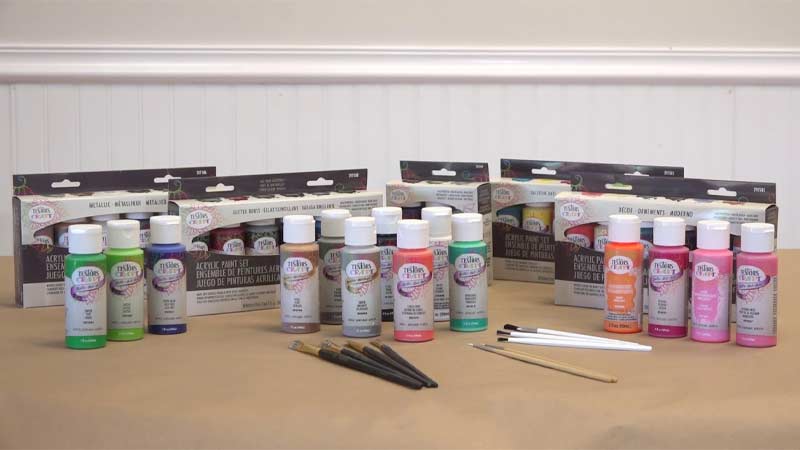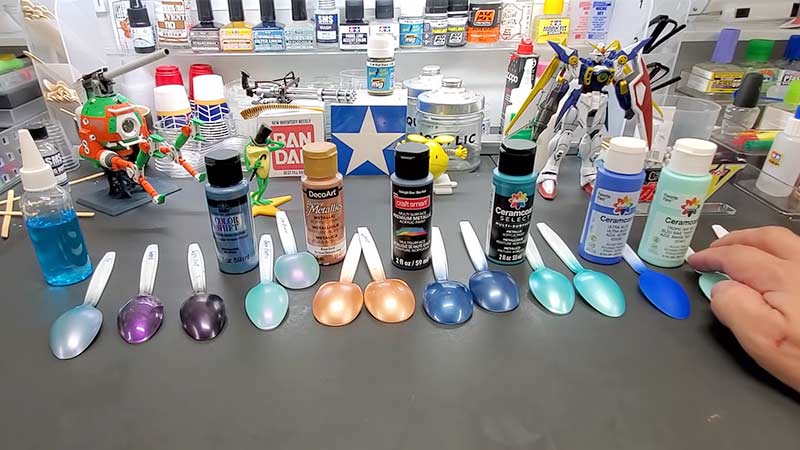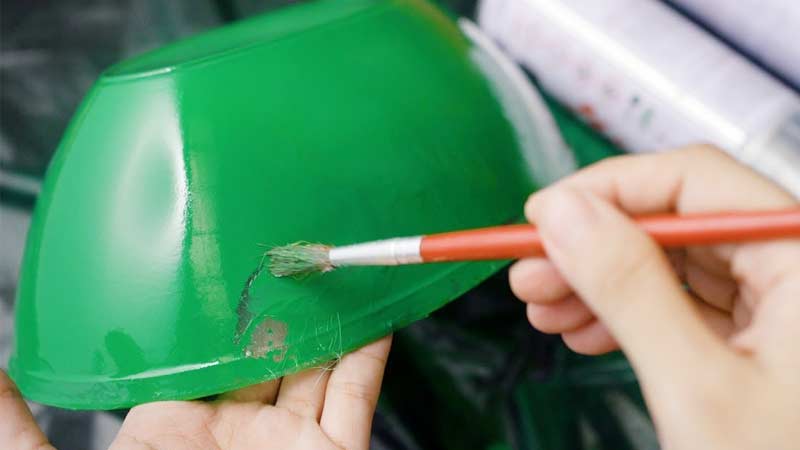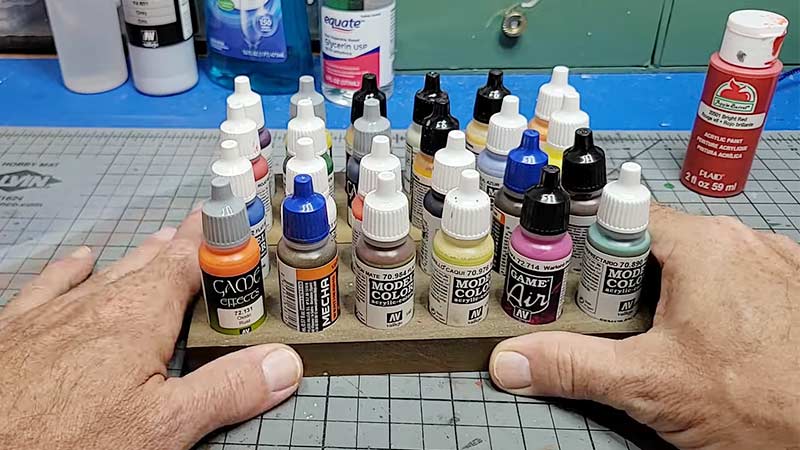Embarking on creative projects often involves exploring diverse materials, and when it comes to crafting on plastic surfaces, the choice of paint becomes pivotal.
Testors Craft Paint emerges as a contender in water-based paints, celebrated for its versatility in general crafting endeavours.
However, a fundamental question lingers: Will Testors Craft Paint Work on Plastic? This exploration delves into the compatibility, application nuances, and considerations surrounding using Testors Craft Paint on plastic surfaces.
Unravelling the possibilities and tips for optimal outcomes, this guide aims to empower crafting enthusiasts seeking vibrant expressions on the versatile canvas of plastic materials.

What Is Testors Craft Paint? 5 Key Features Available
Testors Craft Paint is a line of water-based paints designed for general crafting and hobby use. Manufactured by Testors, a well-known brand in the hobby and modelling industry, Testors Craft Paint is formulated to be versatile and user-friendly.
Key features include:
1. Water-Based Formula
Testors Craft Paint is water-based, making it easy to clean up with water. This feature also contributes to its low odour compared to solvent-based paints.
2. Versatility
The paint is suitable for various surfaces, including wood, metal, plastic, and more, making it a popular choice for crafting projects.
3. Colour Variety and Finishes
Testors Craft Paint is available in a broad spectrum of colours and finishes, including matte, gloss, metallic, and glitter, allowing for creative flexibility.
4. Non-Toxic
The formulation is designed to be non-toxic, making it safer for use in crafting projects, including those involving children.
5. Ease of Use
Testors Craft Paint is easy to work with and can be applied using brushes, sponges, or airbrushes, catering to different application preferences.
Will Testors Craft Paint Work on Plastic?

Yes, Testors Craft Paint is well-suited for plastic surfaces in crafting projects. This water-based paint adheres effectively to plastic, offering a versatile and user-friendly option. To ensure optimal results, start by cleaning the plastic surface thoroughly.
Optionally, lightly sanding and priming may enhance adhesion. Shake the paint container well before use. Apply the craft paint with a brush, sponge, or airbrush, allowing each coat to dry completely.
For added protection and a glossy finish, consider applying a clear varnish. Testors Craft Paint provides a broad colour range and finishes, making it suitable for creative endeavours involving plastic materials.
How to Use Testor Craft Paint on Plastic? A Step-By-Step Guide

Using Testors Craft Paint on plastic involves several steps to ensure good adhesion and a smooth finish. Here’s a step-by-step guide:
Clean the Plastic Surface
Begin by cleaning the plastic surface thoroughly. Use a mild detergent, soap, or rubbing alcohol to remove dirt, grease, or contaminants. This step is crucial for promoting better paint adhesion.
Surface Preparation (Optional)
Optionally, you can lightly sand the plastic surface with a fine-grit sandpaper. This creates a bit of texture, improving the adherence of the paint. Wipe away any dust generated by sanding.
Priming (Optional)
While Testors Craft Paint is often used without a primer, a primer specifically designed for plastics can enhance paint adhesion. Apply a thin, even coat of primer and let it dry before proceeding.
Shake the Paint
Shake the Testor Craft Paint well before use. Ensure that the pigments are thoroughly mixed for consistent colour and coverage.
Application
Apply the craft paint using a brush, sponge, or airbrush. Use thin, even coats to prevent drips and ensure proper drying. Allow each coat to dry completely before applying additional layers.
Drying Time
Allow the painted plastic to dry thoroughly between coats. The drying time can vary based on factors such as humidity and temperature. Check the paint label for recommended drying times.
Clear Coat (Optional)
If additional protection and a glossy finish are desired, apply a clear varnish or sealer over the painted surface once the paint has fully cured.
Curing Time
Allow the painted plastic to cure completely. Curing time may be longer than drying time. Check the paint label or instructions for recommended curing times.
6 Types of Plastics Are Compatible With Testors Craft Paint

Testors Craft Paint is generally compatible with various plastics commonly used in crafting and modelling. While it works well on many plastics, the compatibility can vary based on the plastic’s specific composition and surface characteristics.
Here are some types of plastics that are commonly compatible with Testors Craft Paint:
1. Polyethylene (PE)
Commonly used in containers, bottles, and plastic bags, polyethylene is generally compatible with Testors Craft Paint.
2. Polypropylene (PP)
Found in packaging, containers, and certain plastic parts, polypropylene is known to work effectively with Testors Craft Paint.
3. Polyvinyl Chloride (PVC)
Used in pipes, vinyl records, and some craft materials, PVC is a plastic-type generally compatible with Testors Craft Paint.
4. Polystyrene (PS)
Frequently used in foam, disposable cutlery, and plastic models, polystyrene is well-suited for Testors Craft Paint applications.
5. Acrylonitrile Butadiene Styrene (ABS)
Found in various moulded products, including toys and automotive parts, ABS is generally compatible with Testors Craft Paint.
6. Polyethylene Terephthalate (PET)
Used in beverage containers, packaging, and fabric, PET is a type of plastic that is compatible with Testors Craft Paint.
Testors Craft Paint vs Other Types of Paints for Plastic
Testors Craft Paint is a popular brand known for its model and craft paints, including those designed on plastic surfaces.
When comparing Testors Craft Paint with other types of paints for plastic, there are several factors to consider:
Adhesion to Plastic
- Testors Craft Paints are formulated to adhere well to various surfaces, including plastic. They often have special formulations that promote good adhesion without priming.
- Other paints may also be suitable for plastic, depending on their formulations. Acrylic paints, for example, are known for their versatility and can adhere well to plastic surfaces.
Flexibility
- Plastic surfaces can flex and bend, so a flexible paint is important to prevent cracking. Some Testors Craft Paints are designed to be flexible, making them suitable for plastic models and crafts.
- Acrylic paints are generally flexible and can adapt well to the movement of plastic surfaces.
Durability
- Testors Craft Paints are often durable and resistant to wear and tear. They may be suitable for models that are handled or played with.
- Other paints, such as enamel paints, can also provide durability. Enamel paints take longer to dry but can create a hard, durable finish.
Ease of Use
- Testors Craft Paints are designed for hobbyists and crafters, so they are typically easy to use, with good brushability and coverage.
- Acrylic paints are also known for their user-friendly properties. They dry quickly, are water-soluble for easy cleanup, and come in various colours.
Toxicity and Odor
- Testors Craft Paints are often formulated to be non-toxic, making them safer for use, especially in projects involving children.
- Other paints may have varying levels of toxicity. Water-based acrylic paints are generally considered safer and odourless than solvent-based paints like enamels.
Colour Range
- Testors Craft Paints offers various colours suitable for hobby and craft projects.
- Acrylic paints also come in a vast array of colours, providing plenty of options for customization.
FAQs
Can Testors Craft Paint be used on flexible plastics?
Testors Craft Paint generally works well on flexible plastics like vinyl and rubber, but testing on a small area is recommended to ensure adhesion.
Does Testors Craft Paint require a sealer on plastic surfaces?
While not mandatory, applying a clear varnish or sealer can enhance protection and achieve a glossy finish on painted plastic surfaces.
How long does Testors Craft Paint take to cure on plastic?
Curing times may vary based on factors like humidity and temperature. Refer to the paint label or instructions for recommended curing times on plastic.
Can Testors Craft Paint be used on 3D-printed plastic projects?
Testors Craft Paint can be applied to certain 3D-printed plastics, but a compatibility test is advisable due to the variety of materials used in 3D printing.
Are there specific types of plastic to avoid when using Testors Craft Paint?
While Testors Craft Paint is versatile, some plastics may pose challenges. Highly smooth or non-porous plastics may require additional surface preparation.
To Recap
Testors Craft Paint is a promising choice for painting on plastic surfaces, offering a water-based solution that aligns with diverse crafting projects.
While its versatility and ease of use make it suitable for various materials, including plastic, success hinges on meticulous surface preparation and thoughtful application.
Understanding the nuances of plastic types, optional priming, and the impact of finishes allows for informed decision-making.
As crafting enthusiasts embark on their creative journeys, the compatibility of Testors Craft Paint with plastic unveils a spectrum of possibilities.
By adhering to recommended practices, artists can breathe vibrant life into plastic projects, transforming them into personalized masterpieces.
Leave a Reply